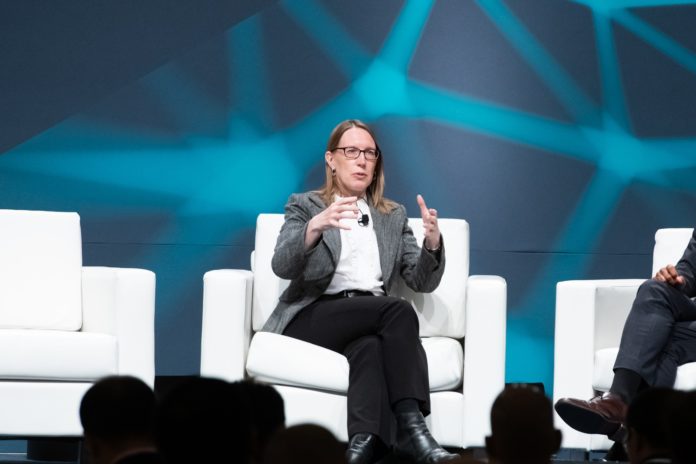[ad_1]
- SEC Commissioner Hester Peirce wants to give token projects three years to adequately decentralize their networks before worrying about securities laws.
- Industry participants believe some kind of so-called “safe harbor” is necessary, and praise Peirce’s proposal for providing a reasonable plan for creating one.
- Questions remain, including how to define network maturity and what happens to tokens deemed immature under Peirce’s definition.
- While Peirce’s proposal will not need an act of Congress to take effect, it will require other SEC commissioners to sign on, and it is unclear whether this proposal can become reality.
The dream of compliant, token-based fundraising in the U.S. received a lifeline from Securities and Exchange Commission (SEC) Commissioner Hester Peirce earlier this month. And though industry observers are generally supportive of the plan, they’re quick to highlight its potential flaws.
Peirce’s “safe harbor” proposal would give crypto entrepreneurs a three-year grace period to launch and decentralize their projects before having to address whether their circulating tokens qualify as securities under federal law. The proposal would have the added benefit of allowing a greater pool of investors to participate in a token sale, she said.
“My hope is I think the same hope that a lot of people in the space have, which is it gives people an opportunity to participate in the economy and society who have before now not been able to participate as fully as they’d like to,” Peirce told CoinDesk in a phone call. “I think it gives the opportunity to people to make decisions for themselves.”
The proposal has been met with mixed reactions, with some praising the potential for more companies to create genuinely decentralized networks and others concerned it may allow scams to propagate unchecked for years under the guise of “good faith.” Others raised questions about the mechanics of defining network decentralization after the three-year period.
Under the proposed rule, dubbed Rule 195, developers would have to disclose their identities, holdings in the token they are working on, any founder’s rewards and a host of other information. They would have three years from the date of the first token sale to “decentralize” their networks, which Peirce defined as the point where no single entity could reasonably modify the network’s functionality. The proposed rule would only apply to new projects issuing tokens for the first time, and not to any existing projects or networks.
CoinDesk spoke to half a dozen industry lawyers and experts to examine the potential implications of the safe harbor proposal. Many agree that a safe harbor is needed, though the specifics of Peirce’s proposal drew a wide range of responses.
Peter Van Valkenburgh, director of research at industry think-tank Coin Center, told CoinDesk the proposal seemed both sober and reasonable, though he noted it does remain only a proposal at the moment.
“For this to become official policy it would have to be bought into from the other commissioners and [SEC Chairman Jay Clayton], so we’d have to wait for that,” he said in a phone call.
Still, CoinList co-founder and president Andy Bromberg said he believed it was unlikely Peirce would have introduced the rule “if she thought it had no chance of moving through the Commission.”
Path forward
Startups, attorneys and advocates in the space praised Peirce’s proposal, saying it gave new tokens an opportunity to build liquidity and give networks the time to mature without getting caught up in securities laws.
Bromberg told CoinDesk that the proposal’s advocacy for putting tokens on exchanges was important.
“We actually want these to be traded on exchanges,” he said. “She was making a statement that a lot of people think were coming from a securities law perspective but it’s important for tokens to be trading.”
Furthermore, the proposal creates some clarity around the idea of what a decentralized network might look like, potentially codifying a definition SEC Director of Corporation Finance William Hinman first suggested nearly two years ago.
The proposal “is trying to put some bright lines” around the idea of network maturity, which needs a safe harbor, said Gabriel Shapiro, an attorney with ZeroLaw.
Projects meeting Peirce’s proposed definition essentially knock out one of the prongs of the Howey Test (the U.S. Supreme Court case usually used as a reference point to determine whether an instrument is a security meant to generate future returns for holders), said Amy Davine Kim, chief policy officer at the Chamber of Digital Commerce.
“What I really liked in this rule is the way they’ve defined network maturity, which is decentralization or a functional network,” she said. “As you know we’ve focused on the Hinman speech, which would be decentralization only and that focuses on one type of business model and may not be appropriate as the market matures.”
The disclosure regime in the proposal is similar to one existing public companies already abide by as well, Van Valkenburgh said. He cited Apple as an example, noting that its investors and the general public trust the technology firm to accurately report earnings, shareholder meetings and disclose the financial or business history of its members.
And while the proposal will still need buy-in from the other SEC commissioners, the Blockchain Association’s Kristin Smith noted that Peirce’s suggestions fit within existing securities law, meaning it would not need a Congressional amendment to take effect.
Not foolproof
The proposal, as it stands, still leaves some questions unanswered, industry lawyers said.
Grant Gulovsen, of Gulovsen Law, told CoinDesk in an email that formal disclosures are “a step in the right direction” but many of the required disclosures already appeared in ICO white papers in 2017.
“With just some minor tweaks I fear that under the terms of the current proposal U.S. investors would be subjected to the exact same series of abuses (and losses) suffered by the rest of the world during the last ICO run,” he said.
He proposed requiring projects to lay out a business plan mapping out their road to profitability and preventing exchanges from “gaming the system to their own benefit.”
“If cryptocurrency exchanges were subject to the same regulatory oversight as traditional exchanges, this would not be an issue,” he said. “But because they’re not, my fear is that they will see this safe harbor proposal as a means of further enriching themselves at the expense of U.S. token sale participants and the projects that list their tokens with these exchanges.”
Shapiro, who shared a written response to Peirce’s proposal last week, told CoinDesk that one aspect he struggles with is the idea that projects are essentially unregulated for three years, apart from regulations around fraud.
He said this part of the proposal may even be seen as “a technology-specific rewrite” of existing securities laws, as the token sale and subsequent transactions could still be securities transactions, they just would not be regulated as such.
Yankun Guo, an attorney with her own practice, echoed Shapiro’s concerns, asking how a three-year exemption can be justified.
Whether the tokens are still essentially securities at the end of the three-year period is another issue: Peirce submitted a definition of what a decentralized network would look like, but it remains unclear what might happen to any networks which do not meet this definition.
“Now you’ve had a bunch of things out there trading as non-securities and now they’re suddenly securities,” Shapiro said. “We shouldn’t rewrite the securities laws. I don’t think the government should be creating incentives for companies to raise money in a certain way via regulatory arbitrage.”
Shapiro recommended lowering compliance costs by reforming securities laws as an alternative solution for crypto projects, noting that the high expense of filing documents and otherwise abiding by the law is one holdup for companies (for example, Blockstack reported paying $2 million when filing to conduct a Regulation A+ token sale last year).
This sort of reform should be addressed across the board, rather than just in one particular area, he said, a view Guo agreed with.
Defining what “good faith and reasonable effort” on the part of the initial development team is another area that needs clarity, Guo told CoinDesk, saying there must be checks and balances on these projects during the three-year period rather than no regulatory requirements.
Building liquidity
Crypto exchanges may also fall under tighter scrutiny under Peirce’s proposal, as part of Rule 195 touts the importance of secondary markets for these new tokens. At the least, these secondary markets would be responsible for potentially creating liquidity around new tokens.
“The problem with token sales in general is that there is a disconnect between whether an underlying project can be profitable and the value of its token on secondary exchanges,” Gulovsen said.
Catherine Coley, CEO of Binance.US, told CoinDesk that the exchange has its own “risk assessment framework” that evaluates whether a cryptocurrency has a use case and the team’s viability.
The exchange, a U.S. affiliate of Binance, currently lists bitcoin, ether, XRP, Qtum, Atom, Dash and 20 other cryptocurrencies.
If adopted, the proposal might help exchanges become more comfortable with listing new assets, Coley said, with the understanding that the developers behind those projects would be required to “maintain quality development,” and would not immediately be classified as securities.
“That gives more comfort to the hunger and appetite to the new coin being listed,” she said.
Whether a new token remains a security at the end of the three-year grace period is “a risk the marketplace is taking,” she said.
This risk does emphasize the importance of exchanges in the U.S. independently ensuring their comfort with tokens they list, she said.
“It’s not peer pressure, we really look through things from our own lens because at the end of the day it’s our risk to manage,” Coley said.
On the other hand, the proposal would allow exchanges to help new projects gain momentum as they get started, she said, and having a token “be blessed” would give marketplaces some comfort in the vetting process.
Gulovsen said adding a regulatory oversight component for exchanges may also help ensure the new secondary markets are not being gamed should also help investors be more comfortable.
One question the proposal does not address in its definition of network maturity is whether mining centralization factors in. A network could have a decentralized group of developers under the proposal but still have a small group of miners or nodes or stakeholders.
Kim said the network might still qualify as mature so long as it is functional, while Peirce said mining centralization is a problem, but not necessarily one that falls under securities law.
Next steps
To take effect, a majority of the SEC’s commissioners would have to vote in favor of implementing the safe harbor proposal. Peirce told CoinDesk that while her fellows are aware of her views on tokens and token projects, she has not yet gone to them directly with the proposal.
Rather, she hopes to gather public feedback and support first. Individuals can email her office or file a comment through FinHub, the SEC’s financial technology branch.
“The next step is to get people to rip it apart and tell me what I did right [or] tell me what I got wrong,” she said. “As much as I can get people interacting with each other as they think about it and then try to take that back to my colleagues and say ‘I think there’s real interest’ and that’s a way to get something on the agenda, send a positive message to the industry.”
There may be a time crunch, however. Coin Center’s Van Valkenburgh noted that Peirce’s term expires this year, and SEC Commissioner Robert Jackson returned to private life last week.
Both Peirce and Clayton can both continue serving in their current roles for another 18 months, assuming successors aren’t nominated, and it is possible that they will be re-nominated by Congress to continue serving. Van Valkenburgh said it is entirely possible the SEC will look different in a year.
Peirce declined to comment on whether she expected to be renominated for another term, though she did say “I certainly don’t feel done with what I want to do at the SEC. I really don’t feel done, there’s lots of work still to be done.”
Disclosure Read More
The leader in blockchain news, CoinDesk is a media outlet that strives for the highest journalistic standards and abides by a strict set of editorial policies. CoinDesk is an independent operating subsidiary of Digital Currency Group, which invests in cryptocurrencies and blockchain startups.
[ad_2]










